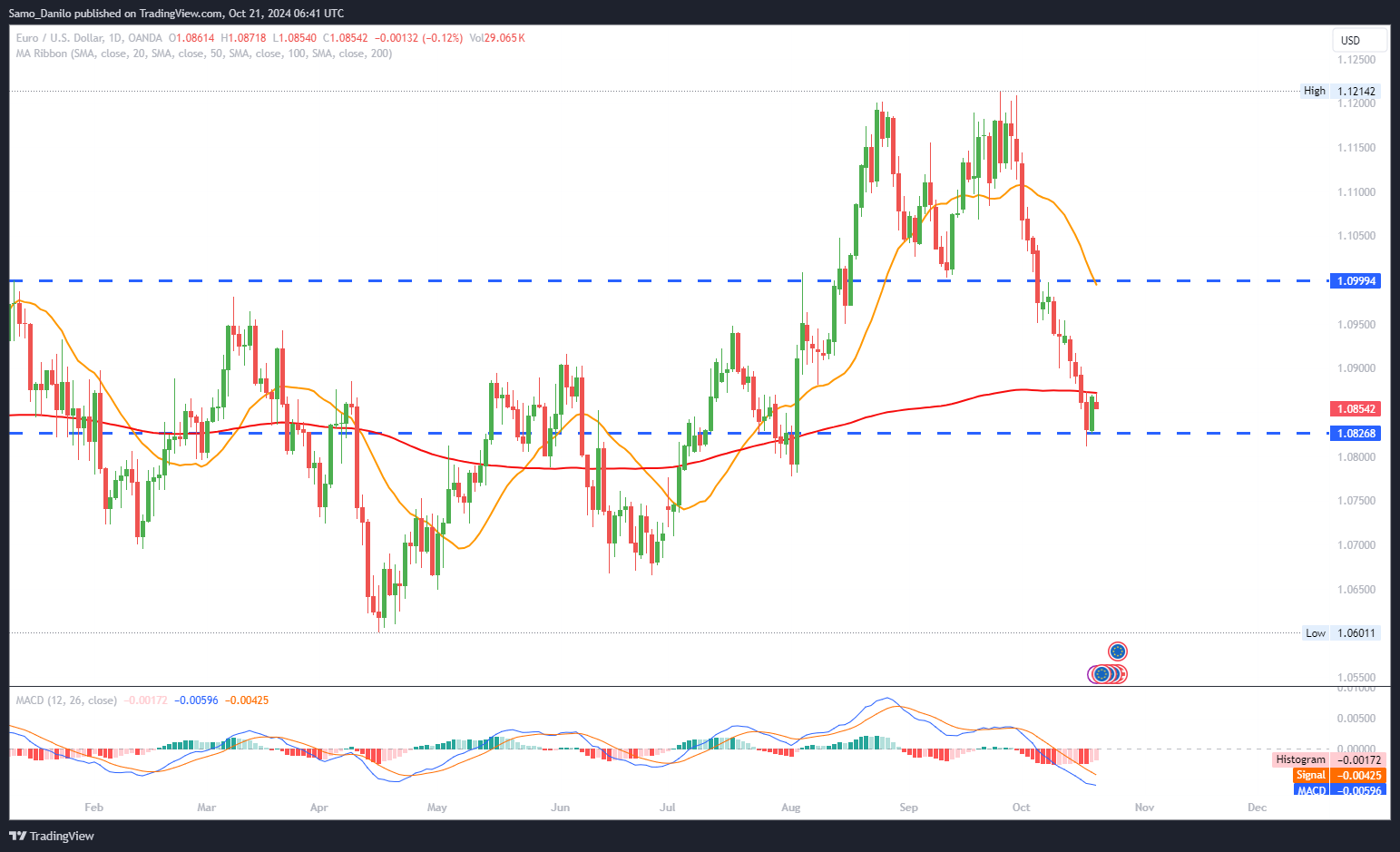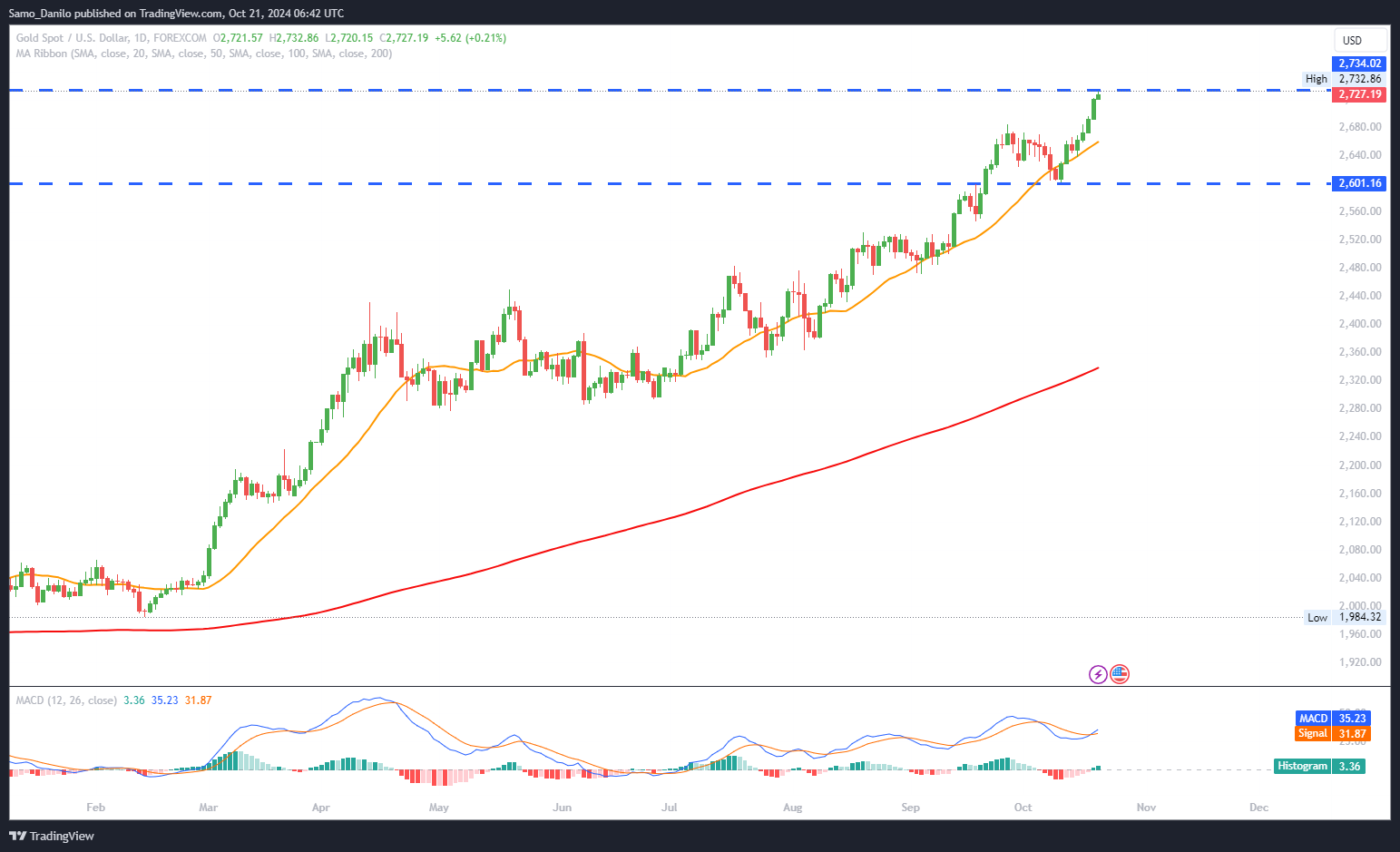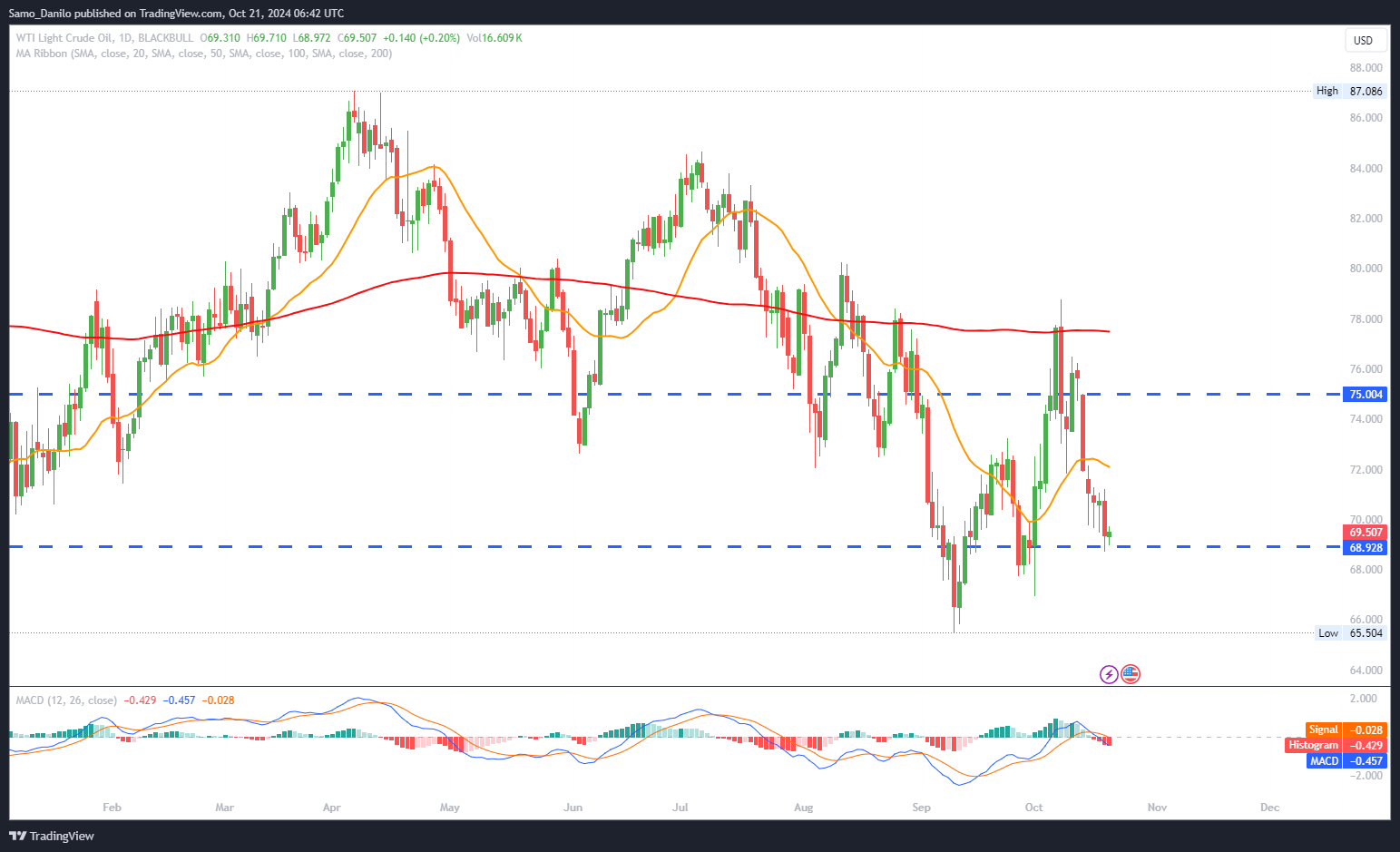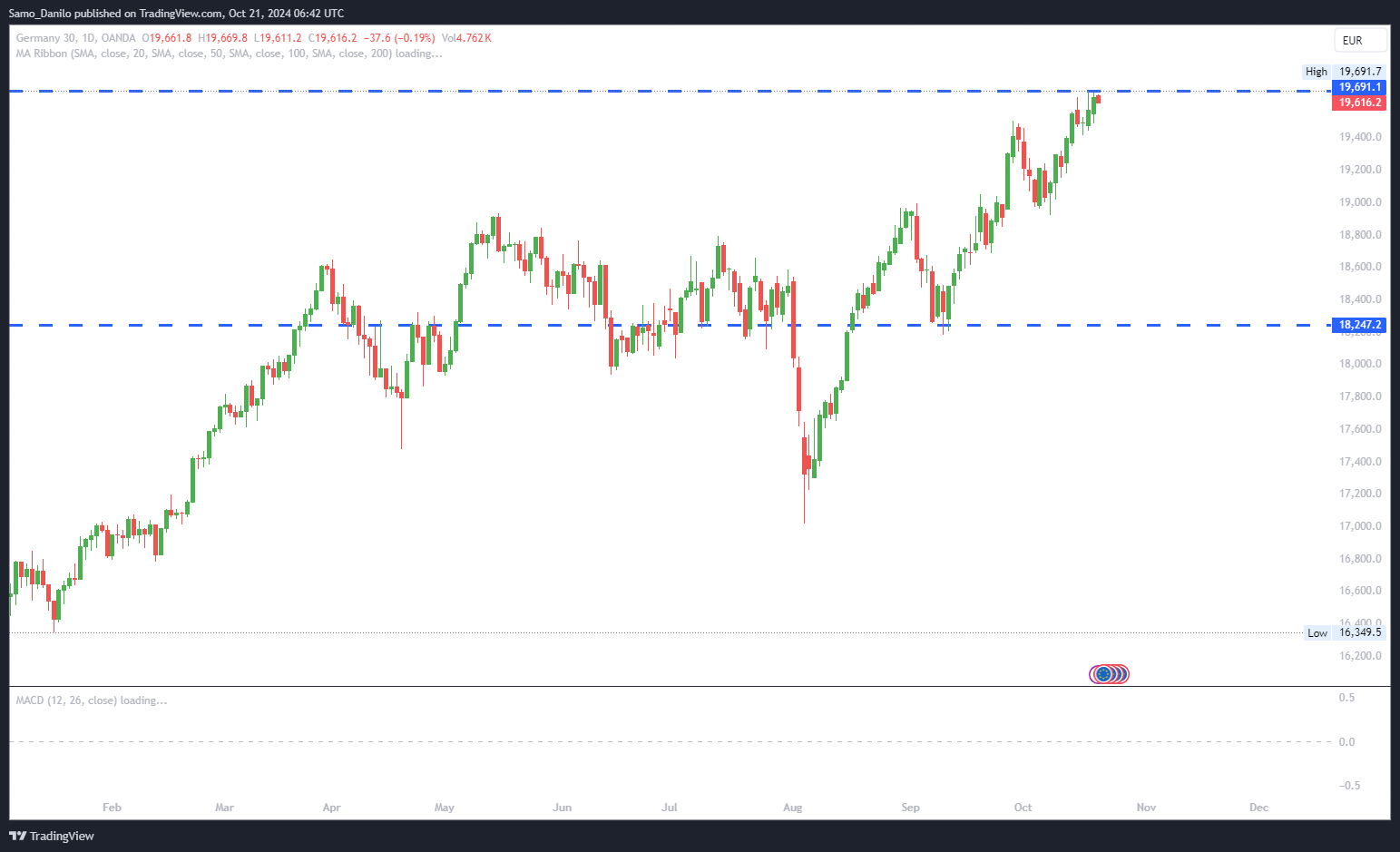EURUSD
- EUR/USD Price: The EUR/USD pair traded around 1.0860 during the European session on Monday, continuing to show signs of weakness. The Euro faced downward pressure amid expectations of more aggressive monetary easing from the European Central Bank (ECB).
- ECB Policy Speculation: Rising speculation that the ECB might accelerate the pace of policy easing contributed to selling pressure on the Euro. At its October meeting, the ECB cut the deposit rate by another 25 basis points (bps), reinforcing the market's anticipation of further rate reductions.
- Lagarde's Remarks: During the post-meeting press conference, ECB President Christine Lagarde acknowledged downside risks to the central bank's inflation outlook. She noted that there is "probably" more risk on the downside than the upside, indicating that inflation might remain subdued for longer than anticipated.
- ECB Comments: ECB policymaker Francois Villeroy de Galhau commented over the weekend that Euro-area consumer price growth is expected to reach the ECB’s 2% target by early 2025, signalling that inflation might take longer to align with the central bank's target.
- Upcoming Speech: Investors are now turning their attention to ECB President Christine Lagarde's upcoming speech on Tuesday. Any further insights into the ECB's monetary policy direction could influence market sentiment and the EUR/USD pair.
Closing statement: The EUR/USD is under pressure as the ECB's dovish stance and the possibility of accelerated policy easing weigh on the Euro. President Lagarde's cautious remarks about inflation risks and comments from ECB officials signal that the Eurozone's inflation outlook remains a key concern. Investors will be closely monitoring Lagarde's speech for additional insights that could shape the currency's near-term direction.
GBPUSD
- GBP/USD Price: The GBP/USD pair started the week on a weaker note, trading lower amid modest US Dollar (USD) strength. The overall market sentiment supports the prospects of further depreciation for the British Pound (GBP).
- USD Buying: The US Dollar saw some dip-buying at the beginning of the week, reversing part of Friday’s losses. This movement was driven by expectations that the Federal Reserve (Fed) will implement modest interest rate cuts over the next year, bolstering the USD.
- BoE Rate Cut Bets: The British Pound is facing downward pressure due to increasing market expectations that the Bank of England (BoE) will cut interest rates in both November and December. This follows a surprise drop in the UK Consumer Price Index (CPI) to its lowest level since April 2021, falling below the BoE’s 2% inflation target.
- UK CPI Data: The sharp decline in inflation has lifted expectations for a 25-basis point (bps) rate cut by the BoE at its upcoming meeting on November 7. This has further undermined the GBP, as traders anticipate a looser monetary policy stance.
- Lack of Major Economic Releases: With no significant economic data scheduled from either the UK or the US early in the week, the fundamental backdrop favors continued downward movement for the GBP/USD pair. The market is focused on the broader macroeconomic factors and central bank policies that suggest further weakness for the Pound.
| SMA (20) | Slightly Falling |
| |
| RSI (14) | Falling |
|
|
| MACD (12, 26, 9) | Falling |
|
|
Closing statement: The GBP/USD pair is under pressure at the start of the week due to USD strength and growing expectations of interest rate cuts by the Bank of England. The surprise drop in UK inflation has intensified these rate cut bets, further weighing on the Pound. In the absence of key economic releases, the GBP/USD is likely to remain biased to the downside in the near term.
GOLD
- Gold Price: The price of gold (XAU/USD) continues its upward momentum, reaching a new record high on Monday. The global trend of major central banks moving towards rate cuts is providing a tailwind for gold prices, as lower interest rates reduce the opportunity cost of holding non-yielding assets like gold.
- PBOC Rate Cut: Chinese stocks have recovered following a larger-than-expected interest rate cut by the People’s Bank of China. The central bank reduced the one-year Loan Prime Rate from 3.35% to 3.10%, which has bolstered risk sentiment in the region and indirectly supported demand for gold as a safe-haven asset.
- Geopolitical Tensions: In the latest geopolitical developments, Israel conducted air strikes on southern Beirut, targeting the offices of Hezbollah’s financial institution, according to Lebanese media outlets. Escalating tensions in the Middle East continue to fuel demand for gold as a hedge against uncertainty.
- ‘Trump Rally’: There is a possibility of resurgent demand for the US Dollar due to growing optimism that Republican nominee Donald Trump could win the 2024 US presidential elections. Markets view Trump’s fiscal and trade policies as potentially inflationary, which could support the Greenback, though this might cap gold’s gains in the medium term.
- Focus on Risk Sentiment and Fed Speeches: With no major US economic data releases scheduled for Monday, traders will closely monitor risk sentiment and speeches from several Federal Reserve policymakers. These factors are expected to provide fresh directional cues for the gold market. Any dovish remarks from Fed officials could further strengthen gold prices.
| SMA (20) | Rising |
|
|
| RSI (14) | Rising |
|
|
| MACD (12, 26, 9) | Rising |
|
|
Closing statement: Gold prices continue to climb, driven by rate-cut expectations from major central banks, rising geopolitical tensions, and support from Chinese policy moves. While optimism around a potential Trump win could boost the USD, the broader fundamental backdrop remains supportive of gold’s safe-haven appeal. Traders will focus on risk sentiment and Fed speeches for additional clues on gold’s next move.
CRUDE OIL
- WTI Oil Price: West Texas Intermediate (WTI) crude oil is trading around $69.00 per barrel during the European session on Monday, recovering after a sharp decline of more than 7% in the previous week. This modest rebound reflects some stabilization in the oil market, though prices remain under pressure from broader market conditions.
- China's Rate Cuts: The potential downside for crude oil prices could be limited as China, the world’s largest oil importer, has recently implemented rate cuts to stimulate domestic economic activity. This policy shift is expected to increase oil demand as China looks to invigorate its economy, which could provide a floor for oil prices.
- Chinese GDP: China's Gross Domestic Product (GDP) grew at an annual rate of 4.6% in the third quarter of 2024, down slightly from 4.7% in the second quarter. Although growth remains steady, the slight deceleration raises concerns about future energy demand, particularly as China plays a crucial role in global oil consumption.
- Geopolitical Tensions: Over the weekend, geopolitical tensions in the Middle East intensified. US President Joe Biden expressed hope for easing conflicts between Israel and Iran, but Israel announced on Sunday that it was preparing to target sites in Beirut linked to Hezbollah’s financial operations. The ongoing conflict in the region continues to affect oil supply sentiment, offering potential support to oil prices as traders weigh the risk of disruptions.
- Shell Pipeline Leak: Reuters reported that Shell and Singapore's Maritime and Port Authority are addressing a leak from a land-based pipeline. While this issue has not had a major impact on global oil prices, it underscores the persistent risks related to infrastructure in key oil hubs.
| SMA (20) | Slightly Rising |
|
| RSI (14) | Slightly Falling |
|
| MACD (12, 26, 9) | Slightly Falling |
|
Closing statement: WTI oil prices have rebounded slightly after a sharp decline, supported by expectations of increased demand from China’s economic stimulus measures. However, uncertainties remain due to slowing Chinese growth and heightened geopolitical risks in the Middle East. Traders will continue to watch developments in both China and the Middle East, as well as any further global economic shifts, to gauge the direction of crude oil prices in the near term.
DAX
- DAX Gains: The DAX Index rose by 0.38% on Friday, continuing its positive momentum from a 0.77% rise on Thursday. Although it didn’t reach Thursday’s intraday all-time high (ATH), the DAX managed to close at a new record high, reflecting strong market sentiment.
- Auto Stocks: Germany’s auto sector was a key driver of the DAX's performance on Friday. Daimler Truck Holdings surged by 6.60%, making it the top performer in the index. Porsche and Volkswagen also posted solid gains, advancing by 1.44% and 1.39%, respectively, as investors continued to show confidence in the German automotive industry.
- Germany PPI: The Federal Statistical Office reported that the producer prices of industrial products in Germany fell by 1.4% in September 2024 compared to the same period in 2023. This marks a sharper decline than the -0.8% year-on-year change in August 2024. On a monthly basis, producer prices were down 0.5% in September compared to August, signaling a potential easing of inflationary pressures in the industrial sector.
- US Housing Data: In the US, housing sector data released on Friday influenced market expectations for the Federal Reserve’s rate path. Building permits declined by 2.9% in September, while housing starts dropped by 0.5%. These weaker-than-expected figures added to concerns about the strength of the US housing market and its potential impact on economic growth.
- Focus on Fed Speakers: Later Monday, investors will turn their attention to comments from key Federal Reserve officials. Any insights into the US economic outlook, labor market conditions, inflation, and future rate decisions could sway market sentiment and influence demand for risk assets, including DAX-listed stocks.
| SMA (20) | Rising |
|
|
| RSI (14) | Rising |
|
|
| MACD (12, 26, 9) | Rising |
|
|
Closing statement: The DAX continues to perform well, hitting new closing highs, supported by strong gains in Germany’s auto sector. Declining producer prices in Germany signal some relief from inflationary pressures, while weak US housing data may affect expectations around the Federal Reserve’s future monetary policy. Market participants will keep a close eye on upcoming Fed speeches for any new signals that could impact risk appetite and the broader market direction.




